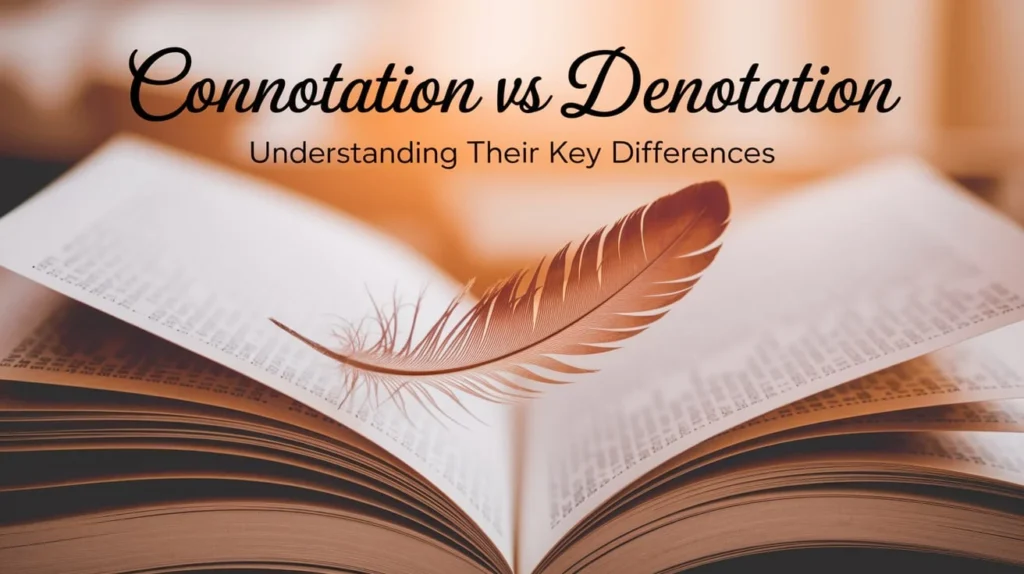Language is more than just a tool for communication; it’s a powerful force that influences how we perceive and interact with the world. Two key elements of language that play a huge role in shaping meaning are connotation vs denotation. While these terms are often used interchangeably, they represent distinct concepts that affect how words are understood. Whether you’re reading a novel, analyzing a political speech, or crafting an ad campaign, knowing the difference between connotation and denotation is essential for effective communication.
In this comprehensive guide, we’ll explore what connotation and denotation mean, how they differ, and why it’s important to understand these differences. By the end of this article, you’ll have a clear understanding of how these linguistic tools shape everything from daily conversations to literature, advertising, and even politics.
What Is Denotation? The Literal Meaning of Words Explained
At its core, denotation refers to the literal or primary meaning of a word—the one you would find in the dictionary. Denotation is straightforward, objective, and factual. It’s the word’s meaning without any emotional undertones or cultural influences.
Examples of Denotation
- Dog: A domesticated carnivorous mammal, scientifically known as Canis lupus familiaris.
- Book: A set of written, printed, or blank pages fastened together.
- Home: A place where someone lives.
When you look up a word in the dictionary, the definition you find is the denotation. It’s what the word literally means, and it doesn’t change based on who is using it or in what context.
What Is Connotation? The Emotional and Cultural Layers of Meaning
While denotation is all about the literal meaning, connotation refers to the emotional, cultural, or subjective associations that a word carries with it. These associations can be positive, negative, or neutral and can vary based on personal experiences, cultural context, and even current events.
Examples of Connotation
- Home: Beyond just being a physical space, “home” connotes feelings of warmth, safety, and comfort.
- Dog: While the literal denotation is just a domesticated animal, the connotation can vary—some people see dogs as loyal companions, while others might associate them with danger or fear.
- Book: A book might connote knowledge, wisdom, or adventure, depending on the context.
These emotional overtones make connotation a powerful tool in shaping communication, adding depth, nuance, and richness to language. Connotation is often influenced by things like culture, media, personal experiences, and societal norms.
Why People Get Confused: Connotation vs. Denotation
It’s easy to get confused by connotation vs. denotation because they both relate to the meaning of words, but they operate in different ways. Here are a few reasons why people mix them up:
- Contextual Overlap: Sometimes, the denotative meaning of a word and its connotative meaning are so closely linked that it’s hard to separate them. For instance, the word “freedom” might denotate the state of being free, but it also connotes strong emotional feelings about liberty and independence.
- Cultural Influences: The meaning of a word can change depending on the cultural context in which it’s used. For example, the word “terrorist” has a negative connotation in Western media but may have a more neutral connotation in some parts of the world, depending on perspective.
- Tone and Intent: When people speak or write, they often don’t just rely on the denotation of words—they also inject connotative meanings based on tone, intent, or the relationship between speaker and listener.
Connotation vs. Denotation: Key Differences Broken Down
Understanding the key differences between connotation and denotation is crucial for navigating language effectively. Here’s a breakdown of their differences:
Definition vs. Interpretation
- Denotation is all about definition. It’s the literal, objective meaning of a word.
- Connotation is more about interpretation. It involves the subjective associations and feelings connected to a word.
Literal vs. Emotional Tone
- Denotation refers to the word’s literal meaning, which remains consistent.
- Connotation deals with the emotional tone a word carries, which can shift based on context.
Fixed vs. Flexible
- The meaning of a word’s denotation is typically fixed and doesn’t change.
- A word’s connotation, however, can be flexible, changing over time or depending on the speaker and the audience.
Usage in Everyday Communication
- Denotation is used when clarity is needed, such as in technical writing or legal contexts.
- Connotation is often employed when trying to invoke emotion, persuade, or convey a deeper meaning.
Cultural and Contextual Variability
- The denotation of a word is usually consistent across different languages and cultures.
- The connotation, however, is deeply influenced by culture and context. A word may have entirely different connotations in different societies or time periods.
Examples of Connotation vs. Denotation in Real Life
In Literature
In literature, connotation plays a significant role in adding layers of meaning. Authors use words with particular connotations to evoke emotions or hint at deeper themes.
For example:
- In Shakespeare’s “Macbeth”, the word “blood” has strong connotations of guilt, violence, and death, beyond its simple denotative meaning of the red liquid that circulates through the body.
In Advertising
Advertising is an industry that heavily relies on connotation. Marketers carefully choose words that evoke specific emotions to persuade customers. For instance:
- The word “luxury” connotes wealth, exclusivity, and comfort, which is why it’s used in high-end product advertisements.
- “Cheap,” while denoting low price, often carries a negative connotation suggesting poor quality.
In Daily Conversation
In casual conversations, we often use words with connotations to express our feelings or to influence how others feel. For example:
- If someone calls another person “ambitious,” they might be implying that the person is driven and admirable—or they could be suggesting that the person is overly competitive or ruthless, depending on the tone and context.
In Politics
Political language is another area where connotation plays a critical role. Politicians choose words that carry certain emotional weight to appeal to their base or criticize their opponents. For instance:
- “Freedom fighter” vs. “terrorist” carries vastly different connotations, despite potentially referring to the same person or group, depending on the speaker’s point of view.
In Media and Journalism
Journalists must be aware of both denotation and connotation when reporting the news. The word choice in headlines can greatly affect how a story is perceived:
- “Protest” can have a neutral connotation, while “riot” carries a much more negative connotation, potentially changing how the reader interprets the event.
How to Use Denotation and Connotation Effectively in Your Writing
To use connotation and denotation effectively, consider these tips:
- Use denotation when you need clarity: In legal, technical, or scientific writing, where precision is paramount, you’ll want to stick with the denotative meaning of words.
- Use connotation for emotional impact: If you’re writing a speech, an advertisement, or persuasive content, pay attention to the connotations of the words you choose. Use words with strong emotional weight to engage your audience.
- Consider your audience’s perception: Words that carry positive connotations for one group of people may have negative connotations for another. Always tailor your language to your specific audience to avoid confusion or misunderstanding.
- Be mindful of tone: Whether writing a novel, a blog post, or a tweet, be conscious of how your words will be interpreted emotionally. Tone can make a significant difference in how your message is received.
Common Mistakes to Avoid When Using Denotation and Connotation
- Assuming all words have the same connotation for everyone: People from different backgrounds may have different emotional reactions to words, so always be mindful of the cultural context.
- Overusing emotionally charged words: While connotation can be powerful, overusing emotionally loaded words can lead to manipulation or confusion.
- Neglecting the literal meaning: Sometimes, the connotation can overshadow the denotation, which might lead to unclear or misleading communication. Make sure your audience understands the literal meaning as well.
Etymology: Where the Words ‘Connotation’ and ‘Denotation’ Come From
Origin and History of ‘Connotation’
The word connotation comes from the Latin word connotare, which means “to signify in addition to.” Over time, its meaning evolved to include the emotional and cultural overtones that a word carries beyond its literal definition.
Origin and History of ‘Denotation’
On the other hand, denotation comes from the Latin word denotare, meaning “to mark or indicate.” It refers to the direct, literal meaning of a word, without any extra emotional or cultural influence.
Conclusion:
In communication, understanding connotation vs. denotation can elevate your language skills and help you navigate the complexities of human interaction. Whether you’re writing an academic paper, crafting a social media post, or engaging in casual conversation, being aware of both the literal and emotional meanings of words will enhance your clarity and precision.
By mastering both denotation and connotation, you can communicate more effectively, avoid misunderstandings, and connect with your audience on a deeper level.

Emma Rose is an experienced English educator, writer, and language enthusiast dedicated to helping learners unlock the full power of the English language. At SynoEnglish, she shares practical grammar tips, clear explanations, and real-world language insights to make learning both effective and enjoyable. With a passion for words and a love for clarity, Emma’s goal is to help readers speak and write with confidence.



